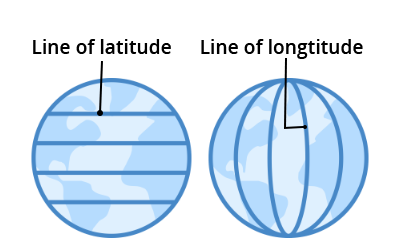Social Science Geography Notes for Chapter 2 Globe Latitudes and Longitudes Class 6 - FREE PDF Download
FAQs on Globe Latitudes and Longitudes Class 6 Social Science Geography Chapter 2 CBSE Notes - 2025-26
1. What is the main concept of a globe as explained in Class 6 Geography Chapter 2?
A globe is a true, miniature 3D model of the Earth. For revision, remember it's the only way to see the correct shape, size, and location of continents and oceans without distortion, unlike a flat map. It can be rotated on its axis, which is the imaginary line it spins around.
2. How can I quickly summarise the difference between latitudes and longitudes for revision?
For a quick summary:
- Latitudes are imaginary horizontal circles that run from east to west. They measure distance north or south of the Equator (0°).
- Longitudes are imaginary semi-circles that run from the North Pole to the South Pole. They measure distance east or west of the Prime Meridian (0°).
3. What are the most important parallels of latitude to remember from this chapter?
Besides the Equator (0°), you should remember four key parallels for your revision notes:
- The Tropic of Cancer (23.5° N) in the Northern Hemisphere.
- The Tropic of Capricorn (23.5° S) in the Southern Hemisphere.
- The Arctic Circle (66.5° N), north of the Equator.
- The Antarctic Circle (66.5° S), south of the Equator.
4. How do the parallels of latitude help in understanding the Earth's Heat Zones?
The key parallels of latitude act as boundaries for the Earth's three main heat zones, a core concept for revision.
- The Torrid Zone, receiving the most direct sunlight, lies between the Tropic of Cancer and the Tropic of Capricorn.
- The Temperate Zones, with moderate temperatures, are found between the Tropics and the Arctic/Antarctic Circles.
- The Frigid Zones, which are very cold, lie beyond the Arctic and Antarctic Circles.
5. What is the core concept of the Prime Meridian and its significance?
The Prime Meridian is the longitude designated as 0°. Its main purpose is to serve as the starting point for measuring longitudes 180° eastward and 180° westward. It passes through Greenwich, UK, and is crucial because it sets the standard for world time.
6. Why does time change as we move across different longitudes?
Time changes with longitude because the Earth rotates on its axis from west to east, taking 24 hours to complete a 360° rotation. This means the Earth's surface moves 15° of longitude every hour (360° / 24 hours). As a result, places to the east of any meridian are ahead in time, while places to the west are behind.
7. Why does a large country like India need a Standard Time (IST)?
India has a vast east-west extent, which creates a time difference of nearly two hours between its easternmost and westernmost points. To avoid confusion for railway, flight, and office schedules, India adopts the local time of a central meridian, 82°30' E, as the Indian Standard Time (IST) for the entire country. This ensures a uniform time for everyone.
8. What is the conceptual relationship between the Equator and the Earth's axis for a quick recap?
The relationship is key to understanding Earth's geography. The axis is the imaginary line passing through the North and South Poles, around which the planet rotates. The Equator is an imaginary circle on the surface that is exactly halfway between the poles. Conceptually, the Equator is at a 90-degree angle to the axis and divides the Earth into the Northern and Southern Hemispheres.

























